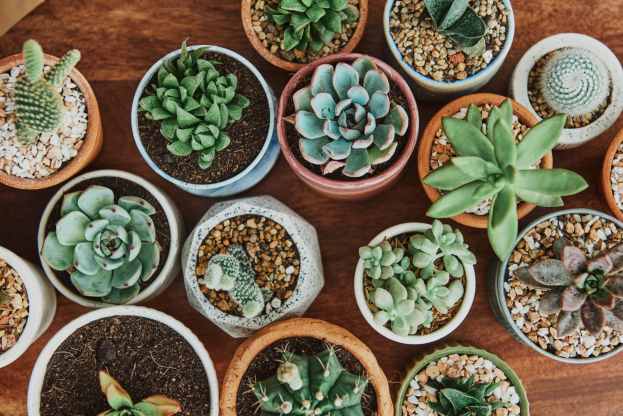TL;DR:
- Succulents are hardy, water-storing plants that thrive with minimal care.
- They need deep but infrequent watering. Always let the soil dry before watering again.
- Place them in bright light (about 6 hours daily) but protect from harsh direct sun.
- Use gritty, well-draining soil in pots with drainage holes to avoid root rot.
- Feed lightly with diluted fertilizer during spring and summer growth.
- Ideal temperatures range between 60°F–80°F; protect them from frost and extreme heat.
- Avoid common mistakes like overwatering, over-fertilizing, poor drainage, and ignoring seasonal needs.
The Magic of Succulents
There's something almost magical about succulents: these hardy survivors that seem to thrive where other plants would simply give up. For amateur gardeners just starting their plant journey, succulents offer the perfect introduction to the world of green thumbs and growing things. They're forgiving, resilient, and surprisingly rewarding to care for.
It’s their incredible adaptability that makes them such beloved houseplants, especially for those who want the joy of greenery without the stress of high-maintenance care routines. It’s also easy to fall in love with these incredible plants, given their varied textures, shapes, and colors.
Understanding how to care for succulents properly is essential to keeping these unique plants thriving. Read on to discover essential succulent care tips and common mistakes you should avoid.
Understanding Succulents and Their Types
Succulents are thick, fleshy plants with a remarkable ability to store water, which helps them survive in arid regions and poor soil conditions. Many keep this reserve in their leaves, giving them a plump look, while others store it in their stems.
A common misconception is that succulents only thrive in deserts, but in reality, they are found across diverse climates and plant families across the world. From houseleeks in the lofty Pyrenees Alps to South Africa’s native ice plant now carpeting California’s coastal highways, succulents prove that their beauty and resilience extend far beyond arid landscapes.
Essential Care Tips for Succulents
Here’s how to care for succulents and nurture their unique characteristics:
1. Give Them Enough Sunlight
Succulents thrive in bright light and usually require six hours of sunlight every day, depending on what species your succulent belongs to. However, it is critical to create a balance and avoid exposing them to extreme, direct sunlight throughout the day. Using a sheer curtain can provide some shade while still allowing enough light to pass through.
This is especially important for newly planted succulents, which can be easily scorched in direct sunshine.
2. Adjust Watering with the Changing Seasons
It is essential to understand your succulent’s water requirements with respect to the season. Succulents, like humans, have higher energy requirements during their growth stages. When these plants are flourishing (in the spring and summer), they consume more water than when they are dormant (in the fall and winter).
Monitor soil moisture by putting your finger about 1.25 inches into the soil. If it feels completely dry at that depth, it’s the right time to water your succulents.
3. Ensure Proper Drainage
One of the most important succulent care tips is to ensure proper storage through the right containers and soil.
Avoid soggy soil, as succulents cannot tolerate excess moisture and may rot. Always use a container with drainage holes to let excess water escape. Terra-cotta pots are suitable for novices due to their excellent drainage capabilities.
4. Select the Right Soil Blend
One of the most important tips for taking care of succulents is choosing the right soil, since poor drainage is the quickest way to damage the plant. A proper potting mix will ensure your plants receive the necessary nutrients. Succulents need well-draining soil, so regular potting mix or garden soil alone isn’t enough. A sandy, porous mix is best for proper drainage.
You can buy ready-made succulent or cactus soil or make your own mix. Potting soil can be used with sand, pumice, or perlite to create DIY mixes.
5. Water the Soil Base for Proper Moisture
When watering, thoroughly soak the soil until excess water starts draining from the holes at the bottom of the pot. Avoid watering with a spray bottle since misting can lead to brittle roots and mildew growth on the leaves.
Alternatively, you can place the pot in a shallow pan of water and allow it to absorb moisture through the holes at the bottom of the pot. Once the layer of soil on the top feels moist, remove the pot to prevent overwatering.
6. Add Fertilizer During the Summer Growing Season
Succulents can benefit from light fertilizer feedings in the spring and summer when they are growing and require more nutrients. Refer to the suggested dosage on the fertilizer container and use half of that quantity, as a general guideline.
7. Consider the Temperature
The optimal temperature for most succulent plants is 60°F to 80°F (15°C to 27°C). Some varieties may be able to tolerate temperatures as low as 40°F or even as high as 90°F.
If you live in areas with harsh winters, bring the potted succulents indoors and place them near a sunny window. Use frost cloths or row covers for outdoor varieties in the garden.
In desert regions, you must protect the plants against the excessive heat and intense sun. To do this, ensure partial shade during peak afternoon hours, use shade cloths, or move the plants to a location with less sunlight. You should also water them in the morning so they can absorb as much of the water as possible before the water dries up.
8. Keep Your Succulents Clean
Indoor plants can accumulate dust on their leaves and surfaces over time. Gently wipe the leaves and spines with a damp cloth. For hard-to-reach areas, use a soft paintbrush to remove dust and debris.
Regular cleaning keeps your plants looking vibrant, supports their overall health, and encourages optimal growth.
9. Remove Pests Infesting Your Succulents
Pests are rare in succulents, but they can occasionally cause damage. Gnats are drawn to succulents grown in overly damp soil with inadequate drainage. To avoid a full-fledged infestation, remove eggs and larvae by spraying the soil with a 70% isopropyl alcohol solution.
Mealybug infestations are primarily caused by overwatering and over-fertilizing. Separate the damaged plants from other succulents and treat them with a 70% isopropyl alcohol solution.
These succulent plant care tips make it easy to create the right conditions for long-term growth.
Common Mistakes to Avoid
Although it’s easy to establish a care routine for succulents, there are a few common mistakes that can significantly impact their health. Here are the most common ones to watch out for:
1. Overwatering
Succulents retain water in their leaves and stems, so frequent watering does more harm than good. Too much moisture quickly leads to root rot, which is one of the main reasons succulents fail.
2. Over-fertilizing
Feeding succulents too often can cause rapid, weak growth that shortens their lifespan. A diluted fertilizer a few times in spring and summer is more than enough.
3. Ignoring Seasonal Needs
Succulents grow actively in warm months and rest during cooler months. Failing to adjust your watering and fertilizing routine with the seasons often stresses the plant.
4. Choosing the Wrong Variety
Not every succulent will thrive in the same setting. For example, frost-tender types won’t survive cold US winters outdoors, while certain low-light varieties adapt better indoors.
5. Neglecting Soil Quality
Using regular potting soil or dense mixes holds too much water around the roots. A gritty, well-draining mix is essential for healthy growth.
6. Poor Drainage
Succulents planted in containers without drainage holes often sit in excess water. This creates the perfect conditions for rot, even if you water sparingly.
7. Missing Stress Signs
Succulents show when something’s wrong: wrinkled leaves, mushy growth, or stretched-out stems all signal a problem. Spotting these early helps you adjust care before it’s too late.
Avoiding these mistakes and following the right succulent care tips will help your plants thrive year-round.
Final Thoughts
While succulents are hardy plants that can thrive in challenging conditions, success depends on understanding their unique needs and following proper succulent care tips. By sticking to the best practices outlined here, you can create a space where these resilient beauties flourish year-round.
Whether you're gifting these low-maintenance plants to a friend who's just starting their plant parent journey, or adding some natural beauty to your apartment or office space, succulents are simply unbeatable as a beginner's first choice. When cared for properly, they bring that touch of green serenity our modern lives desperately crave.
Bring Home Beautiful Succulents with Alpha Floral
Ready to start your succulent journey or surprise someone special with these remarkable plants? Opt for same-day flower delivery and gift the beauty of the greens to your loved ones.
Alpha Floral offers a curated selection of healthy, vibrant succulents and stunning arrangements featuring succulents that make perfect gifts or home additions. Whether you're looking for a single statement piece or a collection of diverse varieties, we'll help you choose the perfect plants for your space and lifestyle.
If you wish to gift a beautiful succulent to your loved ones or add some green beauty to your own space, contact Alpha Floral today. We’re proud to offer lovingly curated flower delivery in Santa Barbara and neighbouring areas.
Call us at (805) 965-5165 or visit us at 1810A Cliff Drive, Santa Barbara, CA, 93109.
FAQs
Q1. Do succulents need direct sunlight?
Ans. The optimal conditions for most succulents involve being placed in bright, direct light, and they typically require at least six hours of natural sunlight each day. However, if your home only offers a shady corner, consider selecting plants that thrive in low-light environments.
Q2. Do succulents need soil or sand?
Ans. Succulents thrive in porous, sandy potting soil. While any type of sand can be used, opting for coarse sand is recommended to ensure efficient drainage.
Q3. Do succulents need big pots?
Ans. While the succulent can survive in a large pot, the extra space does not promote ideal development. Instead, choose a container that allows enough but not too much area for the succulent's root system to thrive.
Q4. How long can succulents go without water?
Ans. Succulents can endure 1-3 months without watering in indoor or cool climates. Indoor succulents experience less exposure to outdoor elements, such as wind and sunlight, which typically dry out the soil more quickly.
In cooler climates, especially during fall and winter, the soil tends to retain moisture for extended periods.
Q5. Can I use plastic pots for succulents?
Ans. Plastic planters used for succulents lack breathability, leading to problems with water drainage. To address this, purchasing plastic pots with drainage holes and using an appropriate succulent soil mix is advisable.

